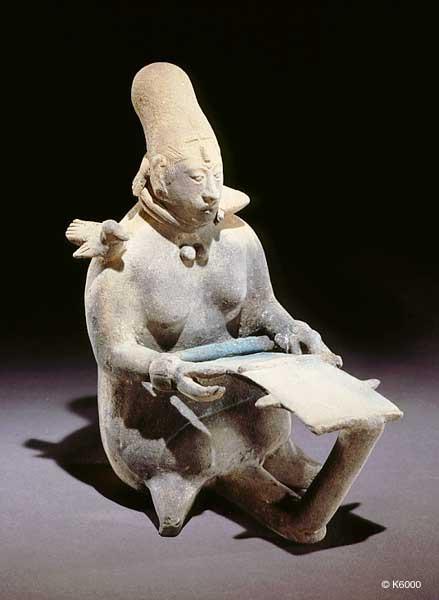As an Andrew W. Mellon Undergraduate Curatorial Fellow, this year in the Art of Ancient Americas Program, one of my favorite activities is object viewings in museum storage, where all sorts of artworks with intricate histories rest, just waiting to have their stories shared. A recent visit left me curious about a small Maya figurine of a graceful woman wearing a huipil, a tunic-like female garment, working on a backstrap loom, with a bird perched on her shoulder. A backstrap loom functions by looping one end around the hips of the weaver, with the other end attached to a tree or post. Weavers then create tension in the warp (vertical threads) by leaning backward or forward, as they insert the weft (horizontal threads) to create cloth, used in clothing like huipils. I learned this small sculpture may be from Jaina Island, off the coast of Campeche, Mexico, the location of many archaeologically excavated burials. Jaina-style figurines are frequently studied and have extensive scholarship, but have been interpreted both as regular people and as supernatural gods, with neither interpretation the all-conclusive story. The diverse narratives made me eager to search further for this weaver’s story.
As I’ve learned, even within the specific canon of Jaina-style figurines, female weaving figurines with birds, like the one in LACMA’s collection, are particularly rare and have diverse interpretations. One interpretation related to the supernatural, by art historian Mary Miller, links the sculptures to depictions of Ixchel, the Maya moon goddess, and a myth of a bird impregnating the goddess with twins. Ixchel is referenced in Maya imagery through various manifestations, like the many versions of the moon, which allow for different female figures to embody her different qualities; the archaeologist Christina Halperin describes this style of figurines in reference to the goddess’s role as patroness of weaving. Explanations related to contemporary everyday Maya culture look more at the weaving figurines as depictions of commonplace activity for Maya women. One interpretation of a similar artwork at the Museo de Antropología in Mexico City suggests that the birds may be depicted as a source of inspiration for the weaving women’s craft, while anthropologist Rosemary Joyce discusses how the small sculptures indicate the origins of female gendered labor in contemporary backstrap loom weaving.

Despite the myriad interpretations, while these sculptures may or may not be everyday Maya women, they depict everyday female activity, and demonstrate a technique that lives on today. My next thought was, if this tradition of weaving still exists, does LACMA have any contemporary examples? I visited Canan Cem, the Andrew W. Mellon Undergraduate Curatorial Fellow in the Department of Costume and Textiles, and consulted with one of her mentors, curator Kaye Spilker, who is the resident expert in ancient American textiles. We uncovered another storage treasure trove: a beautiful huipil, the same type of clothing worn in the ancient sculpture. This contemporary work from Guatemala is constructed of four panels of cloth made using a backstrap loom, then sewn together. It contains exquisite woven geometric patterning, and has detailed embroidered birds at the collar, a coincidental connection to interpretations linking depictions of female weavers to Ixchel the moon goddess and birds.

Wearing a huipil now, for a person of Maya ancestry, is a visual demonstration of community and the retention of indigenous culture. The preservation of Jaina-style figurines, through their fine detail, reveals some history behind the social implications of producing and wearing a huipil, and the garment also informs the ever-growing knowledge of ancient figurines, now far from their original home in Southern Mexico. As I’ve learned throughout my fellowship year working in the Art of Ancient Americas Program, these small details that catch the eye indicate snippets of a rich story, at times lost in the artwork’s route to the museum, but left for curators to uncover, research, and develop into exhibitions.
For further reading:
Cardós de Méndez, Amalia & Marta, Foncerrada de Molina. Las figurillas de Jaina, Campeche en el Museo Nacional de Antropologiá, Museo Nacional de Antropología (Mexico). Instituto de Investigaciones Estéticas de la Universidad Nacional Autonóma de México; Instituto Nacional de Antropologiá e Historia, México, D.F. 1988.
Miller, Mary Ellen. Jaina Figurines: A Study of Maya Iconography. University of Texas Press, Austin. 1975.
Miller, Mary Ellen & Megan E. O’Neil. Maya Art and Architecture, 2nd Edition. Thames & Hudson, London. 2014.
Joyce, Rosemary. “Negotiating Sex and Gender in Classic Maya Society” from Gender in Pre-Hispanic America. Dumbarton Oaks Research Library and Collection, Washington D.C. 2001.
Halperin, Christina T. Maya Figurines: Intersections between State and Household. Trustees of Princeton University, Princeton. 2014.



